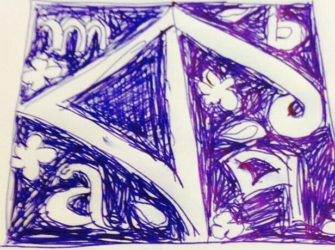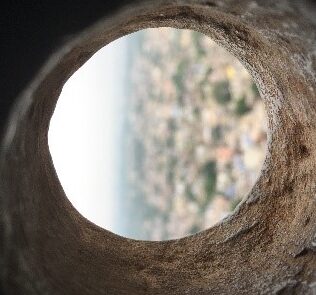We started from Noida by car at 7 in the morning—my brother visiting from UK, my husband and I. My elder daughter was staying back to study and would look after my younger daughter—a black, furry, tail-wagging creature called Chiyo.
It was a slightly cloudy morning. Nice travelling weather, I thought. As we took the Yamuna expressway to Agra, the scenery was actually very pretty. Green fields washed clean by recent rains swept by on both sides. But the driver, too, seemed to be a little green himself, and did not pick up speed even on the excellent empty expressway. Nor did he have any music in the car. And none of us were the type to have ready-made playlists on our mobiles.
But we three had a great time chatting and laughing most of the way. We ate fruits and sandwiches brought from home, and then we all were craving for a cup of tea or coffee. Unfortunately Agra expressway had plenty of signboards for restaurants and eating places, which apparently have been planned, but, as we found, which do not exist in reality. We came across a good place after a couple of hours of travel, a hundred km before we reached Agra. Here we enjoyed South Indian filter coffee and a nice breakfast.
After reaching Agra and having taken the bypass, we unexpectedly went into Rajasthan. Having paid tolls and inter-state charges at a couple of places, we left Dholpur, Rajasthan and crossed into Madhya Pradesh state.
As we crossed into Madhya Pradesh, we came upon a wide open vista with the mighty Chambal river and a wonderful terrain with ravines, and even a fort in
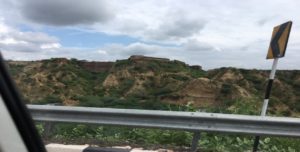
the distance on the hill-top. The view was stunning and we learnt from the driver that was indeed the ‘Chambal’ region of the famed dacoit Phoolan Devi and others, who surrendered to the authorities later.
Next we reached Morena in Madhya Pradesh. So far the road had been quite good, but as we neared our destination Gwalior almost five and a half hours since having left Noida, we encountered some roads which were in a pretty bad condition, more so due to recent rains. After much dancing and tumbling around in the car as a result of the pot-holes on the road, we finally pulled up in
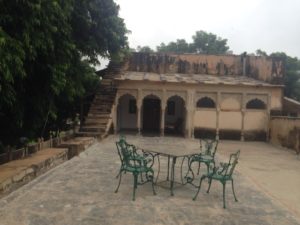
front of our get-away for two days—the Neemrana properties in Deo Bagh.
It was quite unlike a hotel, as the Neemrana Hotels group is so proud to proclaim in their slogan of being Non-hotel Hotels. Deo Bagh is a 17th century property with rambling grounds, greenery, peacocks, old, beautiful rooms and suites. The property has the most amazing ‘family temples’ belonging to the owners, the
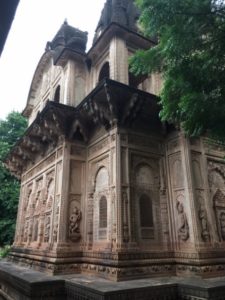
Jadhav family. Earlier in 1500, Mughals camped in the ‘Charbagh’ (four gardens) here. Charbagh is a Persian and Islamic quadrilateral garden layout based on the four gardens of Paradise mentioned in the Qur’an, according to Wikipedia. The quadrilateral garden is divided by walkways or flowing water into four smaller parts.
There is also an impressive central ‘chattis-dwari’ (36 doors) structure in the Deo Bagh gardens. An underground chamber below this structure was meant as a resting-place for women, since it was cooled by a surrounding moat. Apparently the Jadhav family had taken possession of the property and used it as their summer house, when the Maratha army marched towards Delhi.
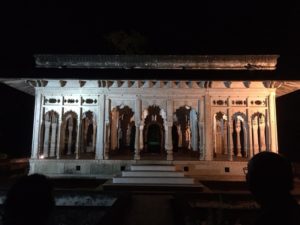
We had reached Deo Bagh at 2 pm. After freshening up, we proceeded towards the Gwalior Fort, just 5-6 km away.
Standing guard atop a hill, Gwalior Fort is a massive fort, the sight of which just took our breath away. The car climbed up a winding road and took us through one of the gates of the fort. Later we learned that people can walk up to the fort through another gate, where cars are not allowed and that this entrance was for cars only.
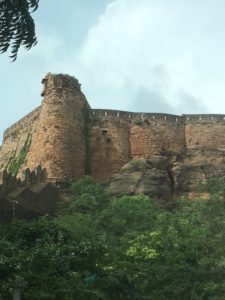
Hiring a guide seemed like a good idea to see the sprawling grounds and fort. Our young guide, Vijay, took us to the main fort-palace and presented a brief history of the palace as we all stood outside in the fort square.
The massive palace was built mainly by Raja Man Singh Tomar in the fifteenth century, although it appeared that additions and modifications have been done to the palace over many centuries, over seven generations and reign of more than hundred kings in all. The fort has been a witness to history as it unfolded over the centuries—having seen the footfall of Hindu kings, Mughal emperors and British soldiers.
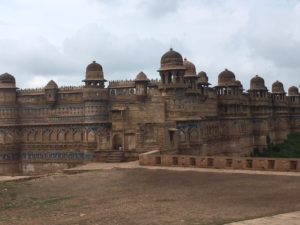
A structure we had passed on the way to the main palace was a stone-made ‘mahal’ which held 52 pillars, where reportedly 52 Hindu kings had been bound and held captive by the Mughals. But the 6th Sikh guru Har Gobind was also kept prisoner here by Jahangir, alongside the kings. Jahangir, upon the advice of his daughter, wanted to free the Sikh guru, but not the kings. Yet the Guru used his wit and got a cloak stitched with 52 hems. Reportedly, when he was released, the 52 kings each held on to the hem of his cloak and was released along with Guru Hargobind.
As we climbed up some steps to the right side of the main palace, we could see the old Gwalior town way down below in the foothills and we were informed that the ‘new Gwalior’ was on the left side of the palace. In the
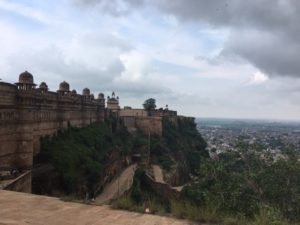
courtyard next to the palace was a place where Raja Man Singh Tomar would hold public audience. Next the guide showed us the carvings on the outer wall of the palace where elephants, ducks, peacocks, makar (crocodiles), banana trees and other such Hindu symbols were engraved. The guide said that the walls had been decorated with bright blue ‘Meena’ work, some of which, we could see, was still visible.
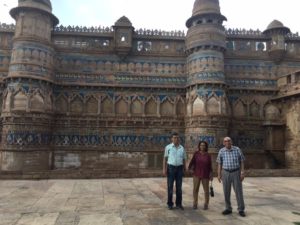
Next we were taken to see the inside of the main palace through a side entrance, which had two magnificent British cannons placed next to it. From inside, the part of the palace we toured was fascinating.
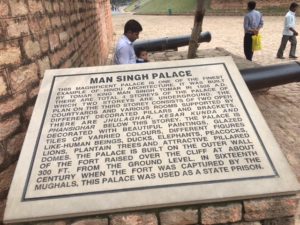
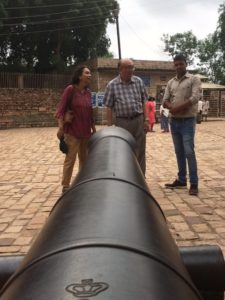
We climbed a flight of stairs and went down a narrow passage to visit a number of enclosed spaces, used earlier as rooms or halls. One was where Raja Man Singh Tomar gave private audience to the people. Another was where his eight queens learnt music from the renowned musician Baiju Bawra. This room had exquisite jali-work all along the walls of
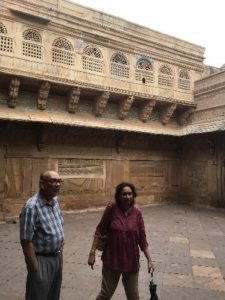
the room at a certain height, with eight distinct such windows of jali or lattice-work. The queens sat behind these ‘jharokas’ while their teacher sat on the floor below. Due to the purdah system, the idea was that the teacher should not be able to see the queens, but the queens would be able to see him.
Here the guide also told us about Raja Man Singh’s ninth queen Mrignayani, who belonged to the ‘lower’ Gujjar caste, and was the daughter of a milkman. The Raja had once gone hunting and in a place found two buffaloes locked in a fight.
No one dared to separate them, but one girl came along, and, taking hold of their horns, pulled them apart. Raja Man Singh was impressed by her strength and wanted to marry her. The simple girl agreed, but with a few conditions which included the following: she would have a palace built separately and would not live in the palace atop the hills. Another condition was that she would accompany the king on his hunting trips. The king agreed and married her. The Gujjar queen Mrignayani’s palace in Gwalior came to be known as
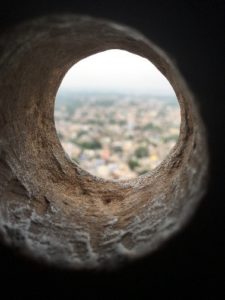
‘Gujari Mahal’. Next we saw the king’s family temple inside the palace with a place for worshipping the Shiva Lingam, as well as a system by which the sunlight used to stream into the temple in the morning right on to the Lingam. In another part of the palace we saw how the outside air would come into the palace through a hole in the wall, and learnt that this draught had passed around a sandalwood fan through a screen of khas-khas to create a natural, fragrant air-conditioning. We sat in front of the hole drilled in the wall and actually felt a cool draught of air.
We had heard about the two underground levels of the palace, but were not prepared for the eerie atmosphere there. We went down a very narrow and steep stone staircase, the path lit only by our mobile phone torches, and came
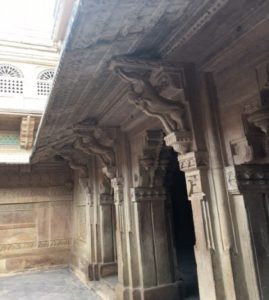
onto a huge round chamber underground with many pillars. The guide showed us pairs of iron rings grouted in the ceiling in the space between each pair of pillars. There were eight pairs of rings in the circular structure where there used to be eight swings or ‘jhulas’ for the eight queens. The British, in later times, had used this chamber for hanging prisoners and it became known as the ‘phansi’ room or the chamber for hanging.
Going down a second flight of steps, there was another round chamber waiting to be discovered. The ceiling here was full of bats, hanging upside down, and some were also flying around. At the centre of the chamber was a large, round well-like structure, its mouth covered by iron grating. The guide informed us that the queens used to bathe in the water in this well, which was scented with saffron. But later the king and his ninth queen were killed during a hunting trip. Hearing this, the remaining eight wives arranged for the well to be drained, lit a big pyre there and entered the fire to give up their lives to follow their husband. This form of voluntary self-immolation to preserve one’s ‘honour’ is known as ‘jawhar’.
As we came out into the sunshine, after visiting the underground chambers,
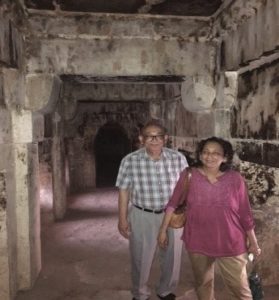
we were feeling steeped in the history of the palace of Raja Man Singh Tomar and it was as if for some time we had been transported back to a long bygone era.
The guide took us next to another section of the fort, which is maintained by the state government, whereas the places we had visited so far are maintained by the central government. This section, a little way off the main palace, has a few buildings, one among which was ‘Karn Mahal’, where other kings and noble men used to live with their families. The British later used much of this section as prisons and some underground chambers as stores for their ammunition.
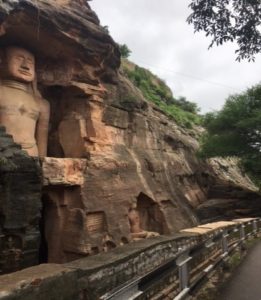
We finished our visit with a quick look at an excellent museum located next to the main palace. The museum has many interesting sculptures and artefacts, including sculptures from the first century B.C. There we also saw some sculptures of icons for the ‘Jain’ religious sect—icons such as Parswanath. The guide informed us that out of several kings who had their rein in the Gwalior fort, there were a few who were followers of the Jain religion. It was then that we recalled that while coming into the fort in our car, we had seen huge sculptures of Jain gurus on the side of the road.
Finally, we finished our tour of the Gwalior fort with steaming cups of Maggi noodles and hot tea, sitting in the dhaba outside the main fort area, but within the wider premises. As we sipped our tea, our thoughts were still roaming around among the ramparts of the fort, slipping behind the stone pillars, stepping into the dark, mysterious underground chambers. It was clear that Gwalior fort had made a permanent place in our hearts.
…. Tanuka Bhaumik Endow

